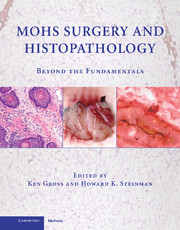Book contents
- Frontmatter
- Contents
- CONTRIBUTORS
- MOHS SURGERY AND HISTOPATHOLOGY
- PART I MICROSCOPY AND TISSUE PREPARATION
- PART II INTRODUCTION TO LABORATORY TECHNIQUES
- PART III MICROANATOMY AND NEOPLASTIC DISEASE
- PART IV SPECIAL TECHNIQUES AND STAINS
- Chap. 18 FIXED-TISSUE MOHS
- Chap. 19 TOLUIDINE BLUE STAIN FOR MOHS MICROGRAPHIC SURGERY
- Chap. 20 FORMS AND TEMPLATES FOR MOHS SURGERY
- INDEX
Chap. 18 - FIXED-TISSUE MOHS
from PART IV - SPECIAL TECHNIQUES AND STAINS
Published online by Cambridge University Press: 03 March 2010
- Frontmatter
- Contents
- CONTRIBUTORS
- MOHS SURGERY AND HISTOPATHOLOGY
- PART I MICROSCOPY AND TISSUE PREPARATION
- PART II INTRODUCTION TO LABORATORY TECHNIQUES
- PART III MICROANATOMY AND NEOPLASTIC DISEASE
- PART IV SPECIAL TECHNIQUES AND STAINS
- Chap. 18 FIXED-TISSUE MOHS
- Chap. 19 TOLUIDINE BLUE STAIN FOR MOHS MICROGRAPHIC SURGERY
- Chap. 20 FORMS AND TEMPLATES FOR MOHS SURGERY
- INDEX
Summary
ZINC CHLORIDE paste (ZCP) is an escharotic and a tissue fixative. Its use in Western medicine was first popularized by Dr. Frederic Mohs for in situ tissue fixation as part of chemosurgery for cutaneous malignancies. Similar formulas were used by other less mainstream healers before Dr. Mohs, and some are still promoted and sold as herbal or natural cancer cures.
Dr. Mohs described the fresh-tissue technique of margin-controlled microscopic surgery without ZCP on carcinoma of the eyelid mucosa, and the routine use of ZCP during Mohs procedures lost favor after Tromovich and Stegman showed similar cure rates for basal cell cancer using fresh frozen tissue technique.
Zinc chloride paste still has utility as an adjuvant to surgery in treating melanoma and in certain situations in contemporary Mohs surgery where tissue fixation can be advantageous. In a retrospective review of patient data, Dr. Mohs had 1.5 times improved survival (P < .003) in patients with significantly thicker melanomas treated with ZCP prior to excision than a similar contemporaneous cohort of patients with thinner melanomas excised at Massachusetts General Hospital without prior pasting. Based on those data, Kalish et al. performed an animal study to determine if pretreating melanoma with ZCP prior to surgical excision improved outcomes. The study compared melanoma recurrence rates in mice when a tumor was either simply excised or first pasted with ZCP followed by excision and then rechallenged with injected melanoma cells.
- Type
- Chapter
- Information
- Mohs Surgery and HistopathologyBeyond the Fundamentals, pp. 151 - 154Publisher: Cambridge University PressPrint publication year: 2009



